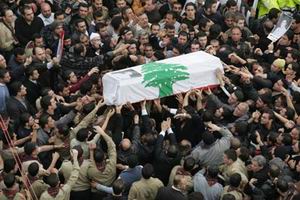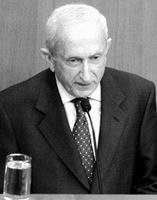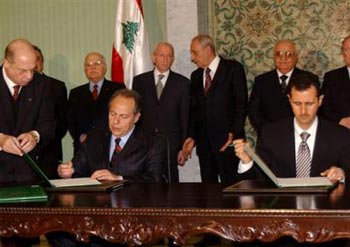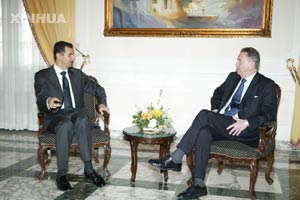

On February 14, former Lebanon Prime Minister
Rafik Hariri, who resigned last fall amid a sharp dispute with Syria and its
Lebanese allies, was killed when massive bomb tore through his
motorcade in Beirut.

(Margaret
Scobey)
On February 15, the United States recalled
its ambassador to Syria,Margaret Scobey,and demanded Syria withdraw
its troops from Lebanon.


On February 16, Hundreds of thousands of Lebanese
mourners gathered at the Mohamed Al Amin Mosque in the capital Beirut to
pay last tribute to former Prime Minister Rafik al-Hariri.

(Photo: AP)
On February 21, tens of thousands of opposition
supporters shouted insults at Syria and demanded the resignation of the
pro-Syrian government in Beirut.
On February 25, the Lebanese defense minister
said yesterday a decision has been made for Syrian troops to pull back from
Lebanon¡¯s coast and mountains to the eastern Bekaa Valley but gave no timeline
and indicated that for now there would be no complete withdrawal as demanded by
the international community.

(Omar karami)
On February 28, Lebanese Prime Minister Omar
Karami announced his government¡¯s resignation,prompting a cheer from more than
25,000 flag-waving opposition demonstrators protesting the government and its
Syrian backers a few hundred meters away.

On March 5, Syrian President Bashar Assad waves
to people from outside the parliament building in Damascus, where he is to
deliver a speech that is expected to announce the withdrawal of Syrian troops
from Lebanon.


On March 6
Above left: a
Lebanese protester shouts slogans as another holds a picture of slain
former Prime Minister Rafik Hariri as they take part in an anti-Syria
demonstration in Martyr's Square in Beirut.
Above right: Pro-Syrian people
ride a vehicle and hold pictures of Syrian President Bashar Assad as they pass a
billboard of the slain former Prime Minister Rafik Hariri during a pro-Syrian
demonstration in Beirut.

(Photo: AP)
On March 7,Lebanese President Emile Lahoud, left,
and his Syrian counterpart Bashar Assad sign documents during a meeting in
Damascus. The presidents met in Damascus to outline plans for a withdrawal of
the Syrian military. While announcing that the troops would redeploy to the
eastern Bekaa Valley closer to the Syrian border by the end of March, they were
vague on the timing of a complete withdrawal from Lebanon.

On March 8, hundreds of thousands of protesters
gathered in Beirut to meet calls from the militant Shiite Muslim Hezbollah group
for a demonstration to counter weeks of massive rallies demanding Syrian forces
leave Lebanon.
On March 10, Lebanese President Emil
Lahoud reappointed pro-Syrian Omar Karami to be the country's new premier,
10 days after Karami resigned because of massive protests and pressure.

On March 11, almost all Syrian troops left north Lebanon,
ending an unbroken 29-year presence and underlining Syria's diminishing role in
its small neighbor.

On March 12, Syrian President Bashar al-Assad
(L) talks with UN Secretary General Kofi Annan's special envoy Terje Roed-Larsen
in Aleppo, northern Syria. Syria was committed to a full withdrawal of troops
and intelligence personnel from neighboring Lebanon, Roed-Larsen said after
talking with Bashar al-Assad Saturday.

On March 14, Thousands of Lebanese opposition
protesters wave national flags as they gather during a demonstration in Martyrs
Square, central Beirut. They answered an opposition call for a massive
protest to demand a full Syrian troop withdrawal, resignations of security
chiefs and an international investigation into the death of former Premier Rafik
Hariri.

On March 15, Syrian intelligence units started to
leave Beirut in a further step toward ending Syria's military presence in
Lebanon. The move came a day after close to a million people rallied in central
Beirut to demand a complete pullout of Syrian troops.
On March 17, Syria's army and intelligence agents
completed the first phase of their pullback to eastern Lebanon and Syria.



